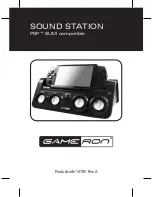
2
Symphony FlexBrackets are compatible with the RotoLock mounting
system (see
Retrofit
, below).
Retrofit
Symphony Speakers feature an integral RotoLock® mounting system for
quick mounting directly into existing ceilings and walls. Once the hole is
cut and the cable is run, you can install the speaker in a matter of seconds.
1. Determine the location for the speaker (see
Speaker Placement
).
2. Perform an obstruction survey to be certain that there are no studs,
conduit, pipes, heating ducts or air returns that will interfere with the
speaker.
3. The cutout for Symphony SS
TR
Speakers is 8
5
/
32
” (207mm). There
also must be at least 5
3
/
16
” (132mm) depth within the ceiling or wall
cavity for the speaker.
4. Find the cutout template provided in the speaker packaging. Position
the template where the speaker is to be located and pencil an outline
on the wall or ceiling.
• If you are unsure about obstructions, drill a small hole in the center
of the outline and insert a coat hanger wire into the hole to
feel-around for possible obstructions.
5. Cut the hole using a drywall saw, and run the speaker wires.
6. Remove the paint plug from the speaker. Connect the speaker wires to
the terminals on the back of the speaker.:
• Connect the left channel amplifier ‘+’ wire to the red ‘Left’ speaker
terminal; connect the left channel amplifier ‘–’ wire to the black ‘Left’
speaker terminal.
• Connect the right channel amplifier ‘+’ wire to the red ‘Right’
speaker terminal; connect the right channel amplifier ‘–’ wire to the
black ‘Right’ speaker terminal.
7. Make sure all the RotoLock clamps are in the full clockwise position
so that they are tucked within the cutout border. Insert the speaker
into the hole in the ceiling.
Note: The RotoLock system can accommodate a maximum wall or
ceiling material thickness of 1
3
/
8
”.
8. Tighten the four screws on the front of the speaker baffle. The
RotoLock clamps will automatically rotate into position and begin
clamping the speaker.
• When you notice resistance on the four screws the speaker has been
clamped successfully.
The speaker flange is designed to flex and conform to any small
imperfections in the wall surface. Do not tighten the screws so much
so that the flange bows-out.
Important: Always use low-torque settings — NEVER over-tighten.
9. Attach the grille after the speaker has been installed. Insert about half
of the grille into the groove at the edge of the speaker. Gently fit the
remaining half of the grille by working around the speaker, fitting the
grille into the groove as you go.
Note: You can adjust the torque applied to the RotoLock screws to
achieve a proper grille fit.
PAINTING THE SPEAKERS AND GRILLES
You can paint the speaker and grille before installing it, which will
eliminate the “paint scar” if the speaker ever needs to be removed for
service. You can also paint the speakers after installation, but before the
grilles are attached. All Symphony speakers come from the factory fitted
with a plastic ‘paint plug’. Use the paint plug to protect the speaker
drivers while the flange is being painted along with the wall.
Sonance always suggests painting the grille separately from the speaker.
Before painting, carefully remove the under-grille cloth. It is held in place
with a light tacking glue that makes it easy to remove.
Spray the grilles with thinned paint (5 parts thinner to 1 part paint),
being careful not to plug the holes. Too heavy a coat of paint on the grille
will adversely affect the sound of the speaker.
Once the grilles and flange are painted and dry, replace the under-grille
cloth, remove the paint plug from the speaker flange and install the grille.
ADJUSTING YOUR SPEAKERS
Tweeter Level Control (S623SS
TR
only)
The Symphony S623SS
TR
has a tweeter level control switch that lets you
boost or cut the tweeters’ level by 3dB.
Once you have installed the
speaker, listen to a variety of
music that you are familiar
with. If the music all tends to
sound too bright, adjust the
level control to the -3dB posi-
tion. If the music all tends to
sound too dull, adjust the level
control to the +3dB position.
If some recordings sound dull
and some sound bright, the
speaker is accurately repro-
ducing differences in the
recordings, and you should
leave the control in the 0dB
position.
Ceiling Joist
FlexBracket Wing
Step 7:
Illustration 1: Symphony FlexBracket Installation
Step 8:
Step 9:
Tweeter
Level
Control
Illustration 2: Tweeter Level Control






















